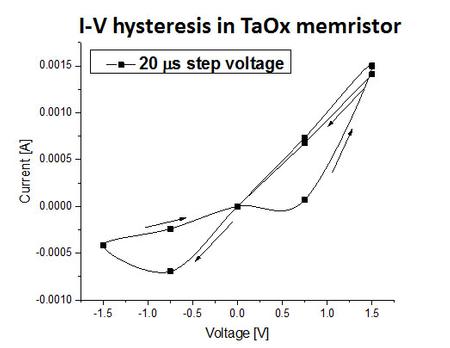Denis Mamaluy (1425) and Xujiao (Suzey) Gao (1355)
Memristors are variable resistors that can be adjusted, reversibly, by applied current. They are one of the strongest candidates to replace flash memory, and possibly DRAM and SRAM in the nearest future. Memristors also have a high potential as a beyond-CMOS technology for logic circuits in novel architectures for high performance computing. In order to aid in the on-going Sandia memristor fabrication efforts and establish clear physical picture of resistance switching in different types of transition metal oxide (TMO) memristors, we are creating a Memristor Charge Transport Simulator (CIS LDRD 173024), based on Sandia’s Charon device simulator code. The Simulator helps to facilitate understanding of switching mechanisms, predict electrical characteristics, and aid Sandia experimentalists in device optimization for different applications. Switching in these devices involves a complex process of oxygen vacancy motion in the TMO film, governed by temporally and spatially intertwined, thermally and electrically driven processes. Thus, computational simulation of these phenomena required a new approach that captures effects of many species transport (ions/vacancies/electrons/holes), changes in material composition, Fickian diffusion, thermophoresis, and electric field drift. Recently we obtained the first practical results for a representative group of TaOx devices, including a semi-quantitatively accurate characteristic hysteresis I-V curves (current-voltage) that reflects the memristive properties of these devices (Figure 1). (Quantitative comparison with experiment awaits further acquisition of the fundamental material properties.) These results confirm the experimental hypothesis that TaOx memristors belong to bipolar-type devices that are strongly influenced by both the electric field and thermal effects (see “type b” in Figure 2). They also demonstrate the capability and value of the Memristor Simulator. The Simulator will now be used to determine the threshold between thermally driven (high power) and electrically driven (low power) TaOx device geometries to select structures best suitable for neuromorphic applications.

![Figure 2. Schematics of conduction channels (red) in switching matrix materials (blue) in four (a-d) types of switching devices, where both electric field and Joule heating drive the switching. The grey arrows indicate the idealized ionic motion. The inset to each schematic shows typical switching current–voltage curve. [J.J.Yang et al., Nature Nanotechnology 8, 13 (2013)].](https://www.sandia.gov/app/uploads/sites/210/2022/06/Figure2_Mamuluy_450.jpg)